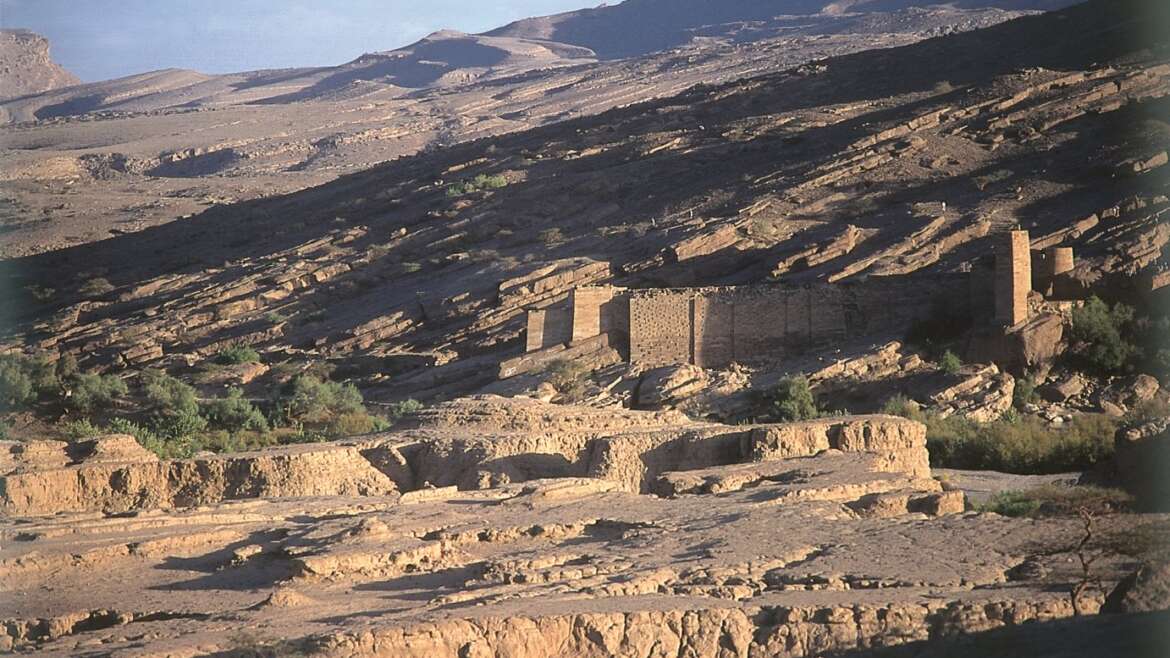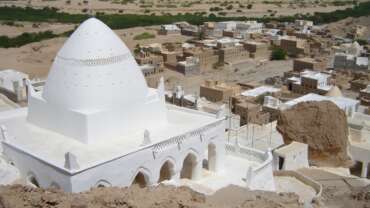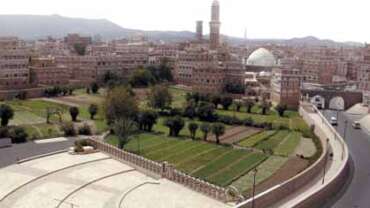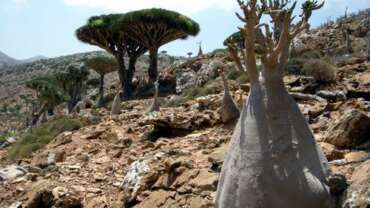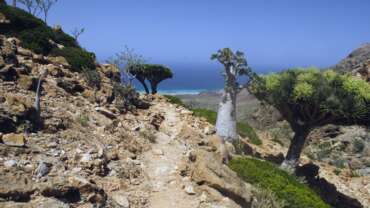Historical Tourism in Yemen
Dam of Marib
Everyone knows about the seven wonders of the ancient world – but there is a monumental structure archeologists and historians like to call the eighth wonder of the world: the Great Marib Dam in southern Arabia, in what is today Yemen. The ancient society there demonstrated great engineering ingenuity in order to take advantage of the periodical monsoon rains. Without water there is no life. True to this maxim, the subjects of the ancient Kingdom of Sheba in Marib collected water by building a gigantic dam so as to be able to supply their cities with this precious liquid. Antiquity brought to life Time and again, archeologists and historians have ventured back into history to discover new chapters.
Marib is also the site of one of the world’s great ancient structures – a magnificent feat of early engineering and masonry techniques. This is the dam across Wadi Adhana, the largest wadi in the south Arabian highlands. Its purpose was to hold and to divert the water, which flooded down the wadi from time to time during the rainy season, over the nearby agricultural land.
It would have also allowed the water to soak into the ground and recharge the aquifers, thus supplying the wells. Recent excavations by the German Archaeological Institute show that, while the structure whose impressive remains stand clear today was erected in the eighth century BC, irrigation works in the Wadi Adhana at Marib were undertaken at least from the beginning of the second millennium BC.
The two masonry sluices of the much repaired eighth century dam remain: the northern one, usually approached first, and the southern one on the other side of the wadi, which is more extensive and almost as high as it was originally.
They demonstrate the Sabaeans’ skill in quarrying the stone blocks, cutting and dressing them, transporting them to the site and then erecting them and binding them together with lead and iron.
Between them once stretched the dam, an earth bank 600m long and 16m high covering a foundation of loose, broken stones. Al little of this rockfill barrage remains and all along its line the massive piles of siltdeposited by the floods can be seen.
The dam is believed to have held up to 150.000 cubic meters of water. The remains of the irrigation system and the system of canals around the dam can still be seen on the plain in front of it.
Bilquis Throne
The great temple of Marib, the Awwam (sometimes called Mahram Bilqis) is dedicated to the moon god Almaqah. It was partly excavated by Wendell Phillips’ expedition of 1951-2. A series of monolithic pillars, probably the propylaeum, mark the entrance to the temple, which may have been used as a sanctuary. The finest sculpture of the ancient Arabs, a figurative bronze of a Sabaean nobleman Ma’adiKarib (of probably the seventh or eighth century BC) was originally found here. It is now in the National Museum. ArshBilqis – the Throne of Bilqis – is the second most important temple in Marib. A line of five elegant symmetrical pillars, also known as the Almaqah or Moon Temple, was built towards the end of the eighth century BC.
This has now been extensively excavated, uncovering a broad temple floor surrounded by steps and inscribed marble plinths. It has a pure abstraction and geometrisation that can be seen in Yemeni structures even Today.
Shiharah
Soon after passing Al Qabai, the famous seventeenth century bridge comes into view, which join the mountain of Alamir and the mountain of Alfeesh. This astonishing work was constructed by the architect Salah Al –Yamanto connect the settlement of Shiharah tough limestone blocks. The bridge is one of the iconic . A cursory glance at the base of the arch reveals the existence of earlier attempts to bridge this narrow yet precipitous gap. The bridge, along with Dar al-Hajar and the walled city of Shibam, has become one of the main images of Yemeni tourism, and it appears on the 10YR coin.
The biggest problem with visiting Shaharah has been its greatest asset throughout the centuries – its sheer inaccessibility. A trip to visit the village necessitates a good deal of time, and usually involves an overnight stay.
So, if you view the trip as a means to experience remote mountain villages and glimpse a peek at tribal culture, with the added bonus that you will be able to witness an amazing architectural masterpiece, the benefits will start to weight in a favour of a trip.
Even so, when you reach the bridge, try to refrain as long as you can from taking a picture. Far too many tourists simply snap a picture and then retreat to the safety of their hotels within five minutes.
Sit down, take in the scenery, and enjoy it. (Granted, the view of the bridge may be too much for the camera finger to bear. Just remember to enjoy the trip while you are there, as well as vicariously through photos later).
Tarim Palaces
Tarim is famous for its innumerable palaces – a collection of approximately thirty mansions constructed between the 1870s and 1930s. During the late 19th and early 20th centuries, Hadhramaut’s merchant families grew rich from trade and investments abroad. The al-Kaf family was considered the most influential. Many members of the family were respected religious scholars. At the same time, they were among the regions first Westernizing elite and contributed to public works projects in the name of modernization. Their palaces remain as testament to both their affluence and the complex identity of the modernizing elite of the colonial period. Palaces financed by the al-Kafs and other families were executed in the stylistic idioms they encountered in British India and Southeast Asia. Consequently, the palaces include examples of Mughal, British Colonial, Art Nouveau, Deco, Rococo, Neo-Classical, and Modernist styles unparalleled in Yemen. While these foreign decorative styles were incorporated into the Tarimi architectural idiom, traditional Hadhrami construction techniques based on the thousand-year-old traditions of unfired mud brick and lime plasters served as the primary methods for executing these buildings.
Tarim’s famous Al-Muhdar mosque is crowned by a 53 meters (175 ft) high, and recognized to be one of the tallest earth structures in the world. The minaret was designed by the local poets Abu Bakr bin Shihab and Alawi Al Mash’hûr. Completed in 1914, the al-Muhdar mosque is named in honor of Omar Al-Muhdar, a Muslim leader who resided in the city during the 15th century.
Al-Kafs Palace is Tarim’s most flamboyan, apparently using a book of different architectural styles as a templatre, kind of project. It was beautiful in old days, havinf the mirror ceiling, decor pillars inside the palace. Going up to the 3rd level and get a splendid view of the city of Tarim.
Wadi Dhahr
Near to Sana’a, WadiDhar has most local species of inland birds, except vultures; but particularly interesting is the mule track from Shibam up to Kawkaban. This 45 minute walk rises nearly 923 m, with Tristrams Grackle, larks, wheatears and doves in abundance at the bottom, eagles, ravens and vultures at the top. There is also a good variety of flowering plants where water trickles through cracks in the rock. The high plateau from Kawkaban, west to WadiHajjar, has some hyaena. The road from Amran to Hajjar is a spectacular series of twisting bends dropping steeply through dark, sombre mountains, down from high altitude to tropical wadi and up again, with such a variety of terrain there is life of all types. Here, in the village of Suq al-Wadi, stands a famous rock palace. Its commanding position and evidence of an ancient well suggest that the site has been used as a lookout post for centuries. It is a classic example of Yemeni architecture and was built in 1786 by Imam Mansour Ali Bin Mahdi Abbas; in the 1930s Imam Yahya Hamid Al Din extended it as a summer residence.
Today, the palace is an open museum of sorts, and a very popular place to visit, not only for tourists but also for local Yemeni families. Different rooms have descriptive labels in English and Arabic. Nearby is the village of Qaryat al- Qabil, with its walled pathways, orchards and vineyards. Here on Fridays from 09.00 – 12.00 Yemenis gather for wedding celebrations.
Baraqish
The name Baraqish was according to a female dog. When the town was surrounded by invaders and it was difficult to conquer the town, there was a secret tunnel leading to a well and the dog Baragish went through that tunnel for water and the invaders noticed that and controlled the well and the people of the town could not hold on without water and had to surrender. The original name was Yathol. Dated back to around the 10th BC, it is the most impressive archaeological site and best preserved ancient walled town in Yemen. It once had more than fifty towers and two gates, and its walls reached up to 14m high. Lying in the wide WadiFardha, it was previously known as Yathil, the dominant town in the Minaeen kingdom and an important centre for the incense trade.
The Sabaeans had controlled this whole region but by the end of the great Sabaean era in 410 BC. Main broke away and formed an alliance with Hadramout to open up new caravan routes and thus increase trade.
We know that the tales of royal towns and palaces in Arabia, the Emperor Augustus instructed the proconsul of Egypt, Aelius Gallus, to invade the peninsula and seize the wealth of the citadels of which he had heard so much. In 24 BC a force of 10.000 Romans and 15.000 mercenaries was assembled and sent to the region with Nabataean Marib.
The force never got back to the Mediterranean and the sea, however, once they had understood the pattern of the monsoons. In the main area of the site, there stand, the remains of a dome, a mosque, a well and tower amidst great shreds of pottery and glass.
Elsewhere an Italian archaeological team has recently excavated a temple which still had its roof and contained stone tables equipped with bull’s heads at the end. These may have been for sacrifices; the temple is thought to be to a god of healing.
Shibam Hadramuot
It is the first skyscraper in the world and at the 3rd century AD it became the capital of Hadhramout region. The houses were built to protect the people from the high tide of the torrent that used to cover the whole valley, so people would escape to the higher floors till the water went down. The city had existed for several centuries before its promotion, and it had been besieged in previous years before the Himyarite Kingdom finally proved superior to that of Hadhramout.
Most tourists come to Shibam to see the city itself. In the early 1930s, Freya Stark and Hans Helfritz made separate journeys to Shibam, the former coining the town the “Manhattan of the Desert” and the latter the “Chicago of the Desert”.
The city is a marvel of mud-brick skyscrapers, densely packed together on a small mound, and which extend upward some five to eight storeys. Since 1982, te city has been recognized as a World Heritage Site by UNESCO.
The architectural style and design of the city on the whole is unlike anything else in Yemen. The most popular theory to account for this is that residents fleeing from the destroyed city of Shabwa rebuilt Shibam, their new home, based on the design and structure of Shaqir, the great palace of Shabwa. The theory makes sense – the inhabitants would no doubt long for a piece of their old home with them.
The image of these monolithic buildings jutting heavenward in the isolation of the surrounding countryside is truly spectacular, and viewing the panoramic image at sunset, when the sky and buildings become playful with colours, makes your camera finger itch to take a snapshot like little else can.
The best place to relieve that itch is on the mountain of Jabal Khidba, where you can get a bird’s-eye view of the city by climbing only a short distance up the path.
From the old fortification or from the top of the mountain, you will be able to see the entire city, including the town gate, the walled fortification that surrounds Shibam, and the large Maruf ba Jamal Mosque to the left of the town.
There is another mosque of the same name within the city wakks, Vitg were founded by the 16th – century scholar who lent them his name.
Walking through the streets of Shibam, you can view the large houses in more intimate detail. From this perspective, one of the most interesting things about the buildings is their elaborately carved wooden doors, doorframes, and locks. Some of the doorframes, in particular, are quite old- the one from Bayt Abdullah bin Fakik is said to date back to 1609, and that of Bayt Ali ibn Hayasa to 1717.
Kawkaban
Legendry Kawkaban means “two stars” and it picked this name due to the walls of Kawkaban which was decorated with precious stones and silver pieces and they were glittering at night and people of Shibam which located down Kawkaban used to see that and started to name it by that name. It sits on top of a 300-metre pile of sandstone deposited by a vast river system some 70 million years ago and subsequently uplifted and eroded to leave the prominent plateau we see today. This rock supplied the raw material for the construction of Kawkaban with its impressive gateway and wall.
It is an ancient site, with a history unraveled in detail by Smith (1982), which has ever provided a refuge for the people of Shibam in times of trouble. The narrow chasm separating Kawkaban from the plateau on the Jebel ad – Dula side known as the Qita, is actually a vertical fault.
At the entrance stands the Turkish barracks (Al Qishlah) with its gate complex including Bab al Hadid or iron gate (actually a wooden gate covered in iron plates). Built in 1895, during the second Turkish occupation of Yemen, it provided modest two – storey accommodation for troops, storerooms and private rooms for the commander.
Inside the town there are some exceptional buildings of beautiful honey-coloured sandstone, which have survived centuries of sieges by Ayyubids, Rasulids and Turks. One is the old mosque, masjid ash-Sharifah, a name acquired in the eighteenth century from Sharifah Muhsinah bint Abdullah bin Ahmed, but of much older construction, with a striking ablution pool.
Built on the centre of the plateau it was originally named after a slave called Sunbul and contains a prominent Himyaritic stone above the entrance door, testifying to the antiquity of the settlement.



